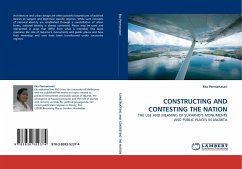Architecture and urban design are often powerful expressions of political desires to support and legitimise specific regimes. While such concepts of national identity are established through a constellation of urban forms, national identity is always contested. Places may be used and interpreted in ways that differ from what is intended. This book examines the role of Sukarno s monuments and public places and how their meanings and uses have been transformed under successive regimes.
Bitte wählen Sie Ihr Anliegen aus.
Rechnungen
Retourenschein anfordern
Bestellstatus
Storno

